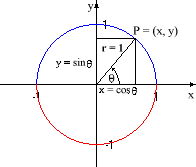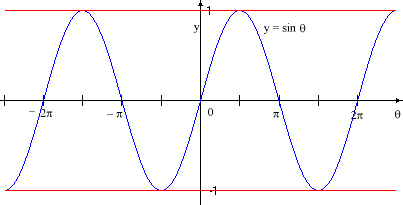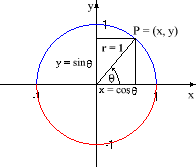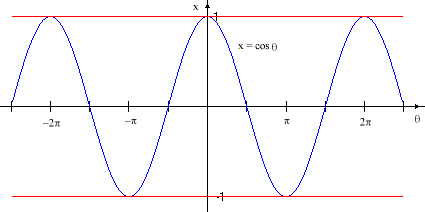


We have created this site to educate the average highschool student about the difficult subject of Trigonometry 2. This site has many links to very good sites pertaining to Trigonometry. It is interactive, and has the opportunity for students to attempt some Trigonometric plroblems. I hope you enjoy the site, and learn about the interesting topic of Trigonometry 2.
The Best Things About Trigonometry
History and Applications of Trigonometry
What can you do with trig? Historically, it was developed for astronomy and geography, but scientists have been using it for centuries for other purposes, too. Besides other fields of mathematics, trig is used in physics, engineering, and chemistry. Within mathematics, trig is used in primarily in calculus, linear algebra, and statistics. Since these fields are used throughout the natural and social sciences, trig is a very useful subject to know.

Trigonometric tables were created over two thousand years ago for computations in astronomy. The stars were thought to be fixed on a crystal sphere of great size, and that model was perfect for practical purposes. Only the planets (Mercury, Venus, Mars, Jupiter, Saturn, the moon, and the sun) moved on the sphere. The kind of trigonometry needed to understand positions on a sphere is called spherical trigonometry. Spherical trigonometry is rarely taught now since its job has been taken over by linear algebra. Nonetheless, one application of trigonometry is astronomy.
Although trigonometry was first applied to spheres, it has had greater application to planes. Surveyors have used trigonometry for centuries. Engineers, both military engineers and otherwise, have used trigonometry nearly as long. Physics lays heavy demands on trigonometry. Optics and statics are two early fields of physics that use trigonometry, but all branches of physics use trigonometry since trigonometry aids in understanding space. Related fields such as physical chemistry naturally use trig.
Of course, trigonometry is used throughout mathematics, and, since mathematics is applied throughout the natural and social sciences, trigonometry has many applications. Calculus, linear algebra, and statistics, in particular, use trigonometry and have many applications in the all the sciences.
Angelfire Websites
Angelfire - Free Home Pages
School and Trigonometry Websites
Robinson Secondary School
Trigonometry is nothing more than how to deal with angels versus straight lines. The tricky and complicated part, however, occurs while handling several complicated numbers at once.
If there is anything that distinguishes trigonometry from the rest of geometry, it is that trig depends on angle measurement and quantities determined by the measure of an angle. Of course, all of geometry depends on treating angles as quantities, but in the rest of geometry, angles aren't measured, they're just compared or added or subtracted.
Trigonometric functions such as sine, cosine, and tangent are used in computations in trigonometry. These functions relate measurements of angles to measurements of associated straight lines as described later in this short course.
Trig functions are not easy to compute like polynomials are. So much time goes into computing them in ancient times that tables were made for their values. Even with tables, using trig functions takes time because any use of a trig function involves at least one multiplication or division, and, when several digits are involved, even multiplication and division are slow. In the early 17th century computation sped up with the invention of logarithms and soon after slide rules. With the advent of calculators computation has become easy. Tables, logarithms, and slide rules aren't needed in trigonometric computations. All you have to do is enter the numbers and push a few buttons to get the answer. One of the things that used to make learning trig difficult was performing the computations. That's not a problem anymore!
Trigonometry 2 deals with the Law of Sines and the Law of Cosines. The Law of Sines determines the length of sides and angles when there is only one angle of side given. The Law of Cosines is to calculate one side of a triangle when the angle opposite and the other two sides are known. Can be used in conjunction with the Law of Sines in order to find all sides and angles.
The Law of Sines
From our previous discussion of the unit circle, we know that the y-coordinate of any point P on the circle is given by the sine of the angle q between the positive x-axis and the line between the origin and P.
If one imagines the point P moving around the circle counter-clockwise starting from the point (0, 1) on the x-axis, the y-coordinate of P (which is y = sinq) goes from: y = 0 at q = 0; to y = 1 at q = 90o = p/2; to y = 0 again at q = 180o = p; to y = -1 at q = 270o = 3p/2; then back to y = 0 at q = 360o = 2p. Notice that the starting and ending points are the same; in other words, 0o = 360o = 0 = 2p (last two expressed in radians).
Graph of the Sine Function
If we were to show several circuits around the circle as a graph of the vertical displacement (y-coordinate) vs. the angle, it would look like this:
The Law of Cosines
We know that the x-coordinate of any point P on the circle is given by the cosine of the angle q between the positive x-axis and the line between the origin and P.
If one imagines the point P moving around the circle counter-clockwise starting from the point (0, 1) on the x-axis, the x-coordinate of P (which is x = cosq) goes from:
x = 1 at q = 0 to x = 0 at q = 90o = p/2; to x = -1 at q = 180o = p; to x = 0 at q = 270o = 3p/2; then back to x = 1 at q = 360o = 2p. Notice that the starting and ending points are again the same; in other words, 0o = 360o = 0 = 2p (last two expressed in radians).
Graph of the Cosine Function
If we were to show several circuits around the circle as a graph of the horizontal displacement (x-coordinate) vs. the angle, it would look like this:
As with the sine function, the most obvious single feature of this graph is that it is periodic (a portion of the graph is repeated endlessly). In fact, the period of this function is T = 2p, so any portion of the graph that includes a full period repeats. In particular, the segments
both contain one full period, and either can be used as the repeating segment of the graph. As before with sine, we’ll use a basic period of the cosine function which suits our purpose best. If neither period has a distinct advantage over the other, either one can be used.
We found these exams when learning about Trigonometry ourselves, and want to ensure that they are well accredited. GOOD LUCK!
Mid-Term Examination 1
Free Web Building Help
Angelfire HTML Library
HTML Gear - free polls, guestbooks, and more!
Technical Tutoring
Math World Trigonometry
IB Math Studies Home Page
Trigonometric Equations
International Baccalaureate Organization Home Page







Trigonometry Examination 2

TODD COLLIER
IB Math Studies
Period 5
Mr. Pandza
ARYAN RASHID
IB Math Studies
Mr. Pandza
Thank you for visiting our page at Angelfire.
Please come back and visit again! TRIG ROCKS!!!
SAM STEINBERG
IB Math Studies
Mr. Pandza

